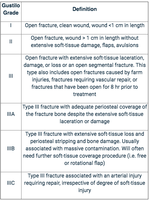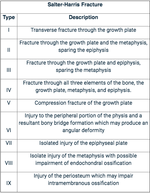You always need to have supporting documentation to code.


 www.icd10monitor.com
www.icd10monitor.com
To provide additional specificity, the fracture seventh characters are expanded to include:
The Gustilo open fracture classification for extremities classifies open fractures into three major categories (types) depending on the mechanism of the injury, soft tissue damage, and degree of skeletal involvement. The classes are I, II, and III, with the third class further subdivided into A, B, or C.
The Gustilo classification is used to identify the severity of the soft tissue damage. Fracture healing, infection, and amputation rates correlate with the degree of soft tissue injury by Gustilo and helps determine the prognosis.
The seventh characters available for these open fractures are:
 www.aapc.com
www.aapc.com
- Type of fracture – closed, open, displaced, nondisplaced
- Specific anatomical site
- Laterality
- Routine versus delayed healing
- Nonunion
- Malunion
- Type of encounter – initial, subsequent, sequela


Coding Fractures in ICD-10: The Right Code Means Everything
It’s no secret that ICD-10-CM offers more codes and increased granularity of data for the coding of orthopedic diagnosis and procedures. And it’s also no
Fracture Coding
ICD-10-CM fracture codes provide greater specificity than ICD-9-CM. For example, ICD-10-CM fracture codes can indicate the fracture type (e.g., greenstick, transverse, oblique, spiral, comminuted, segmental), specific anatomical site, whether the fracture is displaced or not, laterality, routine versus delayed healing, nonunions, and malunions. Laterality and type of encounter (initial, subsequent, sequela) are significant components of the code expansion.To provide additional specificity, the fracture seventh characters are expanded to include:
- A, Initial encounter for closed fracture
- B, Initial encounter for open fracture
- D, Subsequent encounter for fracture with routine healing
- G, Subsequent encounter for fracture with delayed healing
- K, Subsequent encounter for fracture with nonunion
- P, Subsequent encounter for fracture with malunion
- S, Sequela
The Gustilo open fracture classification for extremities classifies open fractures into three major categories (types) depending on the mechanism of the injury, soft tissue damage, and degree of skeletal involvement. The classes are I, II, and III, with the third class further subdivided into A, B, or C.
The Gustilo classification is used to identify the severity of the soft tissue damage. Fracture healing, infection, and amputation rates correlate with the degree of soft tissue injury by Gustilo and helps determine the prognosis.
The seventh characters available for these open fractures are:
- B, Initial encounter for open fracture type I or II
- C, Initial encounter for open fracture type IIIA, IIIB, or IIIC
- E, Subsequent encounter for open fracture type I or II with routine healing
- F, Subsequent encounter for open fracture type IIIA, IIIB, or IIIC with routine healing
- H, Subsequent encounter for open fracture type I or II with delayed healing
- J, Subsequent encounter for open fracture type IIIA, IIIB, or IIIC with delayed healing
- M, Subsequent encounter for open fracture type I or II with nonunion
- N, Subsequent encounter for open fracture type IIIA, IIIB, or IIIC with nonunion
- Q, Subsequent encounter for open fracture type I or II with malunion
- R, Subsequent encounter for open fracture type IIIA, IIIB, or IIIC with malunion
ICD-10: Brush Up on A&P When Coding Fractures
By Rhonda Buckholtz, CPC, CPC-I, CPMA, CGSC, CPEDC, COBGC, CENTC Developing a better understanding of anatomy and pathophysiology (A&P) is one


